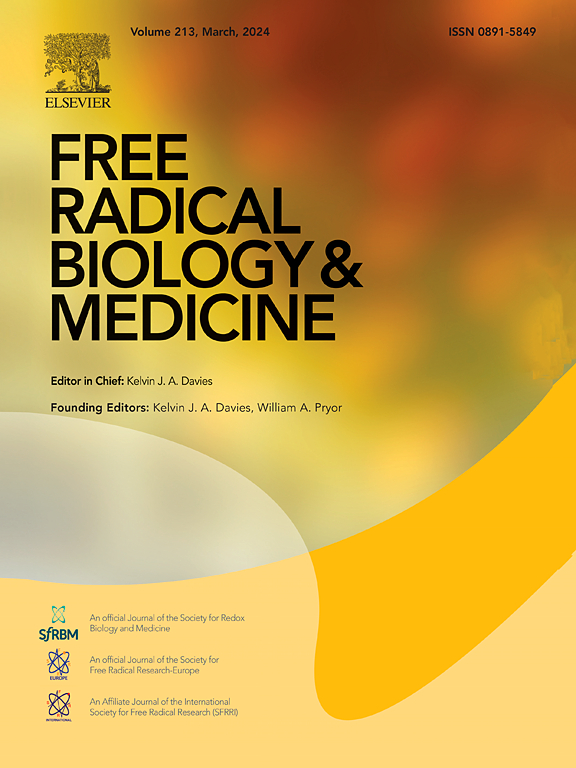来自衰老内皮细胞的外泌体SLC1A5通过EGFR/SRC/YAP1/GPX4信号抑制铁下垂,从而促进胃癌进展
IF 7.1
2区 生物学
Q1 BIOCHEMISTRY & MOLECULAR BIOLOGY
引用次数: 0
摘要
高脂肪饮食和肥胖显著增加胃癌(GC)的风险,持续肥胖导致胃癌发病率显著上升。然而,潜在的分子机制在很大程度上仍不清楚。在这项研究中,我们发现外泌体SLC1A5 (Exo-SLC1A5)是一种促进GC恶性肿瘤的新型衰老相关分泌表型(SASP)因子。外泌体SLC1A5通过抑制铁下垂以gpx4依赖的方式驱动GC进展。在机制上,在肥胖的背景下,衰老的内皮细胞释放外泌体SLC1A5,它与GC细胞上的EGFR结合,触发SRC在Tyr416位点磷酸化,随后在Tyr357位点激活YAP1。这导致YAP1与MYO1B相互作用,增强YAP1的核易位,随后上调GPX4,导致铁下沉抑制和加速GC进展。在体内,在异种移植小鼠模型中,pa诱导的衰老ECs中外泌体SLC1A5的缺失减弱了GC肿瘤的生长和转移。这些发现揭示了外泌体SLC1A5通过EGFR/SRC/YAP1/GPX4信号轴促进GC进展的新机制。靶向Exo-SLC1A5/EGFR/SRC/YAP1/GPX4轴可能提供一种治疗GC的策略。本文章由计算机程序翻译,如有差异,请以英文原文为准。

Exosomal SLC1A5 from senescent endothelial cells promotes gastric cancer progression by dampening ferroptosis via the EGFR/SRC/YAP1/GPX4 signaling
A high-fat diet and obesity significantly increase the risk of gastric cancer (GC), with persistent obesity contributing to a notable rise in GC incidence. However, the underlying molecular mechanisms remain largely unclear. In this study, we identified exosomal SLC1A5 (Exo-SLC1A5) as a novel senescence-associated secretory phenotype (SASP) factor that promotes GC malignancy. Exosomal SLC1A5 drives GC progression by suppressing ferroptosis in a GPX4-dependent manner. Mechanistically, in the context of obesity, senescent endothelial cells release exosomal SLC1A5, which engages EGFR on GC cells, triggering SRC phosphorylation at Tyr416 and subsequent YAP1 activation at Tyr357. This leads to YAP1 interaction with MYO1B to enhance the nuclear translocation of YAP1, and subsequent upregulation of GPX4, resulting in ferroptosis suppression and accelerated GC progression. In vivo, depletion of exosomal SLC1A5 from PA-induced senescent ECs attenuated GC tumor growth and metastasis in a xenograft mouse model. These findings reveal a novel mechanism by which exosomal SLC1A5 promotes GC progression through the EGFR/SRC/YAP1/GPX4 signaling axis. Targeting the Exo-SLC1A5/EGFR/SRC/YAP1/GPX4 axis may provide a therapeutic strategy for GC.
求助全文
通过发布文献求助,成功后即可免费获取论文全文。
去求助
来源期刊

Free Radical Biology and Medicine
医学-内分泌学与代谢
CiteScore
14.00
自引率
4.10%
发文量
850
审稿时长
22 days
期刊介绍:
Free Radical Biology and Medicine is a leading journal in the field of redox biology, which is the study of the role of reactive oxygen species (ROS) and other oxidizing agents in biological systems. The journal serves as a premier forum for publishing innovative and groundbreaking research that explores the redox biology of health and disease, covering a wide range of topics and disciplines. Free Radical Biology and Medicine also commissions Special Issues that highlight recent advances in both basic and clinical research, with a particular emphasis on the mechanisms underlying altered metabolism and redox signaling. These Special Issues aim to provide a focused platform for the latest research in the field, fostering collaboration and knowledge exchange among researchers and clinicians.
 求助内容:
求助内容: 应助结果提醒方式:
应助结果提醒方式:


